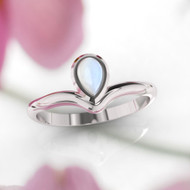How are Moonstones made.
21st May 2023
Formation of Moonstone: Moonstone is formed through a combination of specific geological conditions. It is primarily composed of two types of feldspar minerals: orthoclase and albite. These minerals belong to the silicate group and are commonly found in granite rocks and pegmatite veins.

The formation process of moonstone begins deep within the Earth's crust. Magma, molten rock beneath the surface, undergoes cooling and crystallization over an extended period of time. As the magma cools, it forms intrusive igneous rocks, such as granite, which contain feldspar minerals.
Within these igneous rocks, pegmatite veins can develop. Pegmatites are exceptional in size compared to other veins and contain a diverse range of minerals. These veins often form in the final stages of magma crystallization when the remaining minerals become concentrated in pockets of the rock.
As the magma cools and solidifies, water-rich fluids containing dissolved elements and minerals are released. These fluids percolate through the pegmatite veins, depositing minerals such as orthoclase and albite feldspar along with other trace elements.
During the formation of moonstone, a unique geological phenomenon called exsolution occurs. Orthoclase and albite feldspar minerals separate out into distinct layers within the crystal structure due to differing chemical compositions and cooling rates. This separation creates the characteristic sheen and adularescent glow observed in moonstone.
The interplay of temperature, pressure, and chemical composition during the formation of moonstone is crucial in determining its specific properties and appearance. Variations in these factors can lead to different color varieties, adularescent effects, and overall quality of the gemstone.
Understanding the geological processes involved in moonstone formation provides insights into the remarkable journey this gemstone undergoes before reaching its enchanting state.

